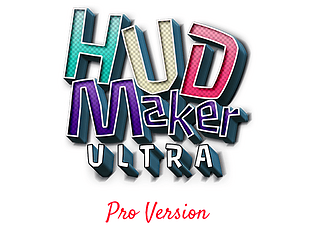Sorry for the slow response! At the current moment, the "params" variable is not available within all code evals. I'll try and fix that in the next update! Thank you for your patience.
SRDude
Creator of
Recent community posts
Sorry for the confusion. Image gauges takes an image and splits it from top to bottom in thirds. The first third is the foreground, and the last third is the background. The middle is the part that is actually changed for the gauge value. Here is an example!
As for hue, unfortunately, there is no way to set the hue color directly, as that's based on the previous color of the image (red at hue 30 is different than blue at hue 30). Instead, I think what you may be referring to is the ability to set the tone of images. Tone lets you set any color as an overlay, but doesn't look as good. But I'll consider adding it in the future! ^^
Thank you for your interest! To answer these questions:
1) Yes. For this you would need to have a Switch bound to the hover of one component (this would make the switch turn on/off depending if the component has the mouse hovered over it). Then the second component can simply have a display condition based on that same Switch.
2) I'm afraid in that case, the hover will still continue. There is no layering system, and multiple components can be hovered, so it would only stop hovering once the mouse left the 200x200 hit-box of the component.
3) Hovering will occur on transparent parts of images. It uses the image's dimensions and a square hit-box. Pixel collision would be too performance heavy to apply on all components, so you'll probably have to find a different plugin for this (or use smaller hit-boxes and create a system similar to question 1).
4) This behavior is not a built-in part of the editor (and there is no automated system for it), but it could be done using the "Code" tab for the inputs of Value/Maximum in gauges (this could probably be done in the normal version of HUD Maker Ultra). However, this would be slightly complicated and require a lot of work.
Long story short, I'm afraid that there is no support for circle gauges even with the Pro version. You could get creative and perhaps replicate something similar, but I don't think any of the Pro features would help that much, and you're much better of experimenting with the normal version of the program.
Hello! I apologize for the delayed response. If you're still having issues, please visit my Discord (http://sumrndm.site/discord) and provide any information you can about the bug!
Thank you very much!
Sorry for the confusion, "HUD Maker Ultra" exclusively works on MZ. This goes for both the pro version and the normal version.
The free version you're referring to appears to be the original "HUD Maker", which is for MV and does not have a paid version.
Yes! I'd recommend trying things out for yourself. Try out the normal version (available for free) here: http://sumrndm.site/hud-maker-ultra
To make a variable gauge, simply select the "Gauge" component, go to "Gauge Value", and then select the "Variable" tab. The gauge bar will now be the same as the number in the variable.
Also be sure to set the "Gauge Maximum" to the plain number you wish to represent the max fill (like 10 or something). You could even set the maximum value to also be based on a variable! 😁
Oooof, I probably should've checked back sooner. XD
All right, I'll investigate that issue as well! In the meantime, the "menu disabled" issue has been resolved!
Download the new "SRD_HUDMakerUltra.js" here (right-click, save-as): https://raw.githubusercontent.com/SumRndmDde/HUDMakerUltra/main/SRD_HUDMakerUltr...
I'll update the one on the itch.io download once I resolve the other bug! ^^
Apologies for the inconvenience! While it's not possible to control the layering with sprites created in other plugins, one solution could be to have certain HUD elements become completely hidden while dialog is occurring.
If you use a "Custom Code" display condition, and input the following: "return !$gameMessage.isBusy();" the component will only appear when there isn't a "Show Message" type event active.
If you're using the "Pro" version, you can even have them fade when appearing/disappearing by using this animation: "Property => Opacity", "Start Opacity => 0.0%", "End Opacity => 100.0%", "Duration => 8", "Activation Type => On Show/Hide".
It would be a bit of a hassle since whenever I need to update the plugin, I'd need to update it in multiple locations. >.<
Not to mention, the normal version is not a demo, it's the full version of the program. The Pro version is more like DLC that adds on top of it. So labeling it as a demo here may cause some confusion.
Thanks for the comment though!


